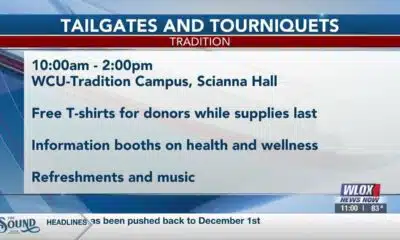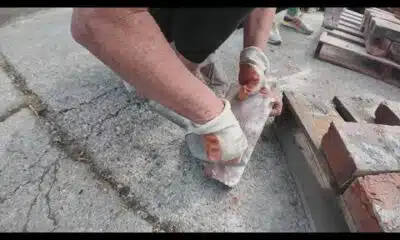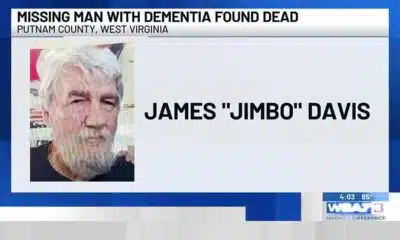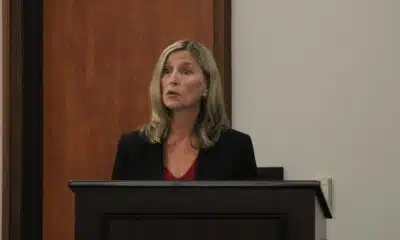News from the South - Alabama News Feed
Woman Paralyzed After Tree Lands on Her Car | May 28, 2025 | News 19 at 5 p.m.
SUMMARY: A woman named Angel Gadgetry was paralyzed after a large tree fell on her car during severe storms in Muscle Shoals, Alabama. She was driving her brother and son to a doctor’s appointment when the storm struck. The tree crushed her car, pinning her inside, but her brother and son escaped unharmed. Angel was rushed to Vanderbilt Hospital in Nashville, where she underwent immediate spinal cord surgery. She is now paralyzed from the waist down but is hopeful and grateful to be alive, attributing her survival to God’s grace. She plans to begin rehabilitation soon after leaving the hospital.
A woman is paralyzed from the chest down after a tree fell on her car during severe storms that rolled through the Shoals on May 20.
News 19 is North Alabama’s News Leader! We are the CBS affiliate in North Alabama and the Tennessee Valley since November 28, 1963.
https://whnt.com/
https://www.facebook.com/whntnews19
https://www.instagram.com/whntnews19/
https://twitter.com/whnt
News from the South - Alabama News Feed
Alabama lawmaker revives bill to allow chaplains in public schools
by Andrea Tinker, Alabama Reflector
September 9, 2025
An Alabama representative is pushing for chaplains to be allowed in public school.
Rep. Mark Gidley, R-Hokes Bluff, prefiled HB 8 for the 2026 legislative session, which starts in January. It would allow school boards to decide whether to allow campus chaplains and teachers in public school.
Gidley has filed similar legislation in the past. The most recent version cleared the House with a vote of 91 to 4 in April but did not make it to the Senate Education Policy Committee. He said in an interview Monday that getting the bill in earlier will give it a better chance to pass.
“We were a little bit late getting it on the floor this past year. It didn’t fail in the Senate because of any problems, it just ran out of time. So I think getting it in earlier is going to help us to be able to work it through both chambers this year,” he said.
Gidley’s goal for the chaplains is that they go to the schools as needed to provide services and support for the faculty and staff in schools. He said this could help teachers in rural counties who lack resources for mental health services.
“It could be a resource they could tap into when they may not be able to tap into other resources that could offer support,” Gidley said.
Critics of the legislation said the measure would violate the separation of church and state in schools.
Each local board of education would vote on whether to approve volunteer chaplains for schools under the measure. If approved by the board, volunteers would have to complete a “recognized chaplain training program” and a background check.
The legislation specifies that schools cannot accept a volunteer who’s been “adjudicated or convicted of an offense that requires registration as a sex offender.”
Sen. Rodger Smitherman, D-Birmingham, backed a similar bill last year. SB294 was passed by the Senate, but it failed to get House approval.
He said in a phone interview Thursday that chaplains are needed in schools.
“We have many situations in our schools that require a need for counseling and for support — not only for students, but for staff and teachers as well,” he said.
Chaplains would provide “support, services and programs” as requested by teachers under the measure. But Smitherman said these types of motions are not meant to replace guidance counselors.
“Some of these situations need additional assistance in the areas that those chaplains can provide,” Smitherman said. “And the guidance counselor is not for the teachers and the staff workers, so this will make it available to them as well.”
Gidley said guidance counselors and chaplains serve different functions within the school.
“They’re not even in the same category and so it’s totally absurd to even think that one would replace the other,” he said. “These chaplains are strictly there for moral, and if need be, spiritual guidance. Whatever the situation is, if somebody needs a confidential nonpartisan place to share something they could be dealing with, I think that could be extremely helpful with our teachers and administrators in the school system.”
The Alabama Legislature will begin meeting Jan. 13.
Alabama Reflector is part of States Newsroom, a nonprofit news network supported by grants and a coalition of donors as a 501c(3) public charity. Alabama Reflector maintains editorial independence. Contact Editor Brian Lyman for questions: info@alabamareflector.com.
The post Alabama lawmaker revives bill to allow chaplains in public schools appeared first on alabamareflector.com
Note: The following A.I. based commentary is not part of the original article, reproduced above, but is offered in the hopes that it will promote greater media literacy and critical thinking, by making any potential bias more visible to the reader –Staff Editor.
Political Bias Rating: Center-Right
This content reflects a center-right political bias primarily through its focus on legislative efforts led by a Republican lawmaker advocating for chaplains in public schools, an initiative often associated with conservative values emphasizing religion in public life. The article presents the bill and its supporters in a factual and balanced manner, including some perspectives of critics concerned about church-state separation, which tempers any overt partisan slant. The respect shown for religious support roles aligned with traditional moral guidance aligns with center-right priorities, while the inclusion of bipartisan mentions adds a moderate tone overall.
News from the South - Alabama News Feed
Judge to decide on evidence, video in Jabari Peoples' death by Friday
SUMMARY: A judge is expected to decide by Friday whether to review police body cam footage related to Jabari Peoples’ death. Peoples was fatally shot by a Homewood officer in June, with the death ruled justified. The family has seen portions of the video but not the full footage or a copy. Peoples’ mother’s legal team requested preservation of all evidence for potential wrongful death litigation. Concerns were raised about discrepancies between what the district attorney and the family observed in the video. Black Lives Matter protesters supported the family’s demand for transparency. The judge requested the investigating agency to submit all related videos for review.
Judge to decide on evidence, video in Jabari Peoples’ death by Friday
Subscribe to WVTM on YouTube now for more: https://bit.ly/2jvAaUD
Get more Birmingham news: http://www.wvtm13.com
Like us: https://www.facebook.com/WVTM13/
Follow us: https://twitter.com/WVTM13
Instagram: https://www.instagram.com/wvtm13/
News from the South - Alabama News Feed
Montgomery court grants temporary restraining order against AHSAA eligibility policy
by Andrea Tinker, Alabama Reflector
September 8, 2025
A state court Friday blocked an Alabama High School Athletic Association (AHSSA) policy barring transfer student-athletes from immediately participating in sports if they receive CHOOSE Act funds amid a lawsuit from Gov. Kay Ivey and Alabama House Speaker Nathaniel Ledbetter, R-Rainsville.
The CHOOSE Act is a voucher-like program that offers families up to $7,000 per qualifying child per year for “non-public education” expenses, including private school tuition. The program currently operates under income caps scheduled to be lifted next year.
The lawsuit, filed in Montgomery County Circuit Court, alleges AHSAA’s rules “specifically and unlawfully sideline CHOOSE Act students from AHSAA-sanctioned interscholastic athletic events for an entire year solely because they receive CHOOSE Act funds.”
“Every child deserves true choice in their education and that includes their right to participate in school athletics,” Ivey said in a statement Friday afternoon. “The court’s decision restores fairness to the process which is, of course, the very basis of the CHOOSE Act.”
A message seeking comment was left with AHSAA on Friday. The AHSAA considers the CHOOSE Act a form of financial aid similar to scholarships or tuition reductions, and it requires students who receive that to be ineligible for sports for one year. AHSAA said in a statement Thursday that the rule is in place to prevent students from having unfair advantages.
“This policy, established by our member schools, promotes competitive equity and deters recruitment,” the organization said in its statement.
When the act was initially introduced in 2024, there was no language about high school athletics. During House floor debate over the bill in February of that year, Rep. Joe Lovvorn, R-Auburn, introduced an amendment saying that “Nothing in this chapter shall affect or change the athletic eligibility of student athletes governed by the Alabama High School Athletic Association or similar association.”
The amendment was adopted on a 74-17 vote. The language remained in the final version of the bill.
Messages seeking comment were left Friday with Lovvorn.
Rep. Danny Garrett, R-Trussville, the sponsor of the CHOOSE Act and the chair of the House Ways and Means Education Committee, wrote in an email Friday that AHSAA was aware the governor and other politicians didn’t agree with the organization’s interpretation of the law.
“The Governor, Lieutenant Governor, Speaker of the House, the chief legislative legal officer and the bill sponsor have expressed the legislative intent of the CHOOSE Act during numerous conversations with AHSAA officials. The AHSAA’s position and response is obtuse, baffling and certainly not with the best interest of children and families in mind,” he wrote.
Ledbetter said in a statement Thursday AHSAA created the policy without getting clarification from policymakers which leaves families at a disadvantage, and implied that action from policymakers could be taken against AHSAA during the upcoming legislative session.
“For the AHSAA’s leadership to take such drastic action just as football season begins tells me they are not concerned with the best interests of all student-athletes.” the statement said. “While I fully expect members of the House and Senate will take a hard look at how the AHSAA operates in the upcoming session, this situation demands action today. My hope is the court will side with our student-athletes and not allow this organization to wrongfully take away their opportunity to compete.”
The AHSAA in 2016 altered its rules to allow homeschooled students to play sports in the public school districts in which they reside.
Alabama Reflector is part of States Newsroom, a nonprofit news network supported by grants and a coalition of donors as a 501c(3) public charity. Alabama Reflector maintains editorial independence. Contact Editor Brian Lyman for questions: info@alabamareflector.com.
The post Montgomery court grants temporary restraining order against AHSAA eligibility policy appeared first on alabamareflector.com
Note: The following A.I. based commentary is not part of the original article, reproduced above, but is offered in the hopes that it will promote greater media literacy and critical thinking, by making any potential bias more visible to the reader –Staff Editor.
Political Bias Rating: Center-Right
This content primarily focuses on a legislative and legal dispute involving a voucher-style education program (the CHOOSE Act) and its impact on high school athletics in Alabama. The CHOOSE Act, supported by prominent Republican figures like Gov. Kay Ivey and Alabama House Speaker Nathaniel Ledbetter, reflects a Center-Right position promoting school choice and private education funding. The article covers the controversy surrounding the Alabama High School Athletic Association’s eligibility rules, presenting statements from both sides without overt editorializing. The emphasis on school vouchers, legislative intent, and intervention to support families’ educational choices aligns with a Center-Right perspective typically associated with Republican policy priorities.
-
News from the South - Texas News Feed6 days ago
Texas high school football scores for Thursday, Sept. 4
-
News from the South - West Virginia News Feed7 days ago
Missing man with dementia found dead
-
News from the South - Louisiana News Feed5 days ago
Portion of Gentilly Ridge Apartments residents return home, others remain displaced
-
News from the South - North Carolina News Feed5 days ago
Hanig will vie for 1st Congressional District seat of Davis | North Carolina
-
News from the South - Alabama News Feed5 days ago
Alabama state employee insurance board to seek more funding, benefit changes
-
Our Mississippi Home6 days ago
The Hummingbirds’ Last Hooray of Summer
-
The Conversation6 days ago
Scientific objectivity is a myth – cultural values and beliefs always influence science and the people who do it
-
News from the South - West Virginia News Feed5 days ago
WV Supreme Court will hear BOE’s appeal in vaccine lawsuit — but not right away













































